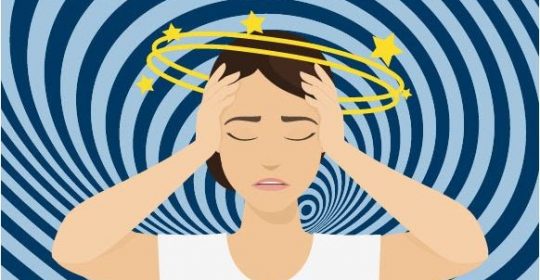
Causes, Symptoms, Treatment & Home Remedies for Vertigo
Vertigo is a sensation that makes people feel as though they’re off balance or dizzy, with many feeling like the world is spinning around them. The term vertigo is often used as a substitute for dizziness as symptoms of the two are similar – motion sickness, lightheadedness as well as trouble balancing. Many people often use the term to describe a fear of heights as well. However, vertigo itself is known to involve the centers of the brain and the inner ear.
If you are experiencing symptoms of vertigo for long periods of time, the licensed neurologists at GNC Dubai can diagnose the problem and recommend medication or exercises to help ease symptoms.
Types of vertigo
Peripheral vertigo results from problems within the inner ear and is the most common type of vertigo. There are tiny organs in the inner ear that respond to gravity and sends messages to the brain about a person’s movement and position. This helps maintain balance when standing up. When there are sudden changes to this system, it may result in vertigo with inflammation and BPPV being the most common causes.
Central vertigo typically relates to problems within the central nervous system and can stem from issues within the brain stem. Problems with the cervical spine can also lead to vertigo.
What causes vertigo?
Vertigo is typically caused by a problem with the inner ear, but can also have different causes depending on whether the cause is central or peripheral. Central causes will arise in the spinal cord or the brain, while peripheral causes are due to problems within the inner ear.
- Benign paroxysmal positional vertigo (BPPV). Within the inner ear, there are structures known as otolith organs that contain crystals of calcium carbonate. With BPPV, the crystals fall into the semicircular canals and can cause irritation. Due to this, the brain will receive wrong information about the person’s position and results in spinning or dizziness sensations. These typically last less than 60 seconds but may result in nausea.
- Vestibular neuritis. The inflammation of the vestibular nerve will not affect a person’s hearing, but is usually related to viral infections and causes inflammation in the inner ear. This cause is also known as labyrinthitis.
- Ménière’s disease. With this disease, there is a buildup of fluid in the inner ear that leads to episodes of vertigo, along with hearing loss or ringing in the ears. Ménière’s disease could be caused by a viral infection or an autoimmune reaction, but the exact cause is unclear. It is more common in people between the ages of 40 and 60.
- Cholesteatoma. This is a skin growth (non-cancerous) that forms in the middle ear due to repeated infections. It can damage the middle ear’s structures as it grows behind the eardrum and can lead to hearing loss and dizziness.
- Central causes of vertigo include concussions or traumatic brain injury, tumors, multiple sclerosis, strokes and vestibular migraines.
- Other causes of vertigo may include ear surgery, perilymphatic fistula, shingles, otosclerosis, syphilis, ataxia and acoustic neuroma.
Symptoms of vertigo
Symptoms of vertigo typically appear even when someone is standing still. These symptoms include loss of balance, or a sense of whirling or spinning. Some may also experience nausea or vomiting. When patients are getting diagnosed, they tend to associate vertigo with dizziness and vice versa. Vertigo will often show signs of abnormal eye movements during physical examinations.
Common symptoms of vertigo include:
- Spinning
- Tilting
- Loss of balance
- Swaying or being pulled to one direction
- Nausea
- Vomiting
- Abnormal eye movements (nystagmus)
- Headaches
- Hearing loss or ringing in the ears
Diagnosis
Doctors will try to determine the cause of vertigo by carrying out physical examinations and reviewing the patient’s medical history. There are also quick tests that can be carried out when diagnosing vertigo, these include:
- Romberg’s test, during which the doctor asks patients to stand with their arms by their sides, with feet together and eyes closed. If the patient appears to become unsteady upon closing their signs, it could be a sign of problems within the central nervous system.
- During the Fukuda-Unterberger’s test, doctors will ask patients to march on the spot for 30 seconds with their eyes closed. If they appear to rotate to one side, this could indicate a problem in the inner ear which would ultimately cause peripheral vertigo.
Doctors may also recommend CT scans or an MRI in order to rule out other diseases and learn more about what is causing dizziness in patients.
How do you treat vertigo?
Some forms of vertigo will resolve without treatment, but other patients may need treatment for underlying problems. Doctors may prescribe antibiotics for bacterial infections or antiviral drugs for infections like shingles. Medications like antihistamines or anti-emetics can reduce feelings of nausea and motion sickness.
Vestibular Rehabilitation
Vestibular rehabilitation is a form of physical therapy that focuses on strengthening the vestibular system in order to communicate more effectively with the brain about the head and body movements relative to gravity.
Medication
Some medications may provide relief but are not recommended for the long-term. Benzodiazepine medications are effective but may cause side effects such as drowsiness. Doctors may prescribe medications to help with symptoms such as nausea or vomiting, but these will not help treat vertigo directly.
Treating Ménière’s Disease
For those with Ménière’s disease, doctors will recommend a low-sodium diet but may also prescribe medication to help relieve dizziness. Patients are also given the option to take antibiotics or corticosteroids and are recommended to limit their sodium intake while avoiding caffeine, chocolate and alcohol.
Home remedies for vertigo
While some types of vertigo may only occur once for some people, other types may recur until an underlying condition is found. There are several home remedies that you can use to treat vertigo if you have constant symptoms at home.
The Epley maneuver
The most effective treatments for BPPV include particle repositioning movements such as the Epley maneuver or a canalith repositioning procedure. During the maneuver, patients are required to perform specific head movements to loosen the crystals within the inner ear. By doing so, it will reduce irritation in the inner ear and resolve symptoms.
Brandt-Daroff exercises
These exercises can help reduce symptoms of positional vertigo. This method involves quickly lying flat from a seated position with your head pointed away from the side that is causing vertigo, and needs to be repeated daily. Other exercises that can help with vertigo symptoms include a half somersault called the Foster maneuver and the Semont maneuver.
Managing stress
Types of vertigo, including Ménière’s disease, are often triggered by stress. Developing stress management strategies can help reduce episodes of vertigo. Meditation and breathing exercises are good starting points when it comes to coping with stress. For triggers that cause long-term stress, it’s important to identify these and take the right steps to cut these triggers out of your life completely in order to help reduce your vertigo symptoms and episodes.
Stay hydrated
Vertigo can sometimes be caused just by dehydration. Reducing sodium levels can help with dehydration but it’s important to make sure that you’re drinking plenty of water throughout the day.

